Can you look at a piece of material and decide if it is a woven or knit fabric? If not, your sewing education is seriously lacking. It may seem trivial, but this is a must know!
As a sewing beginner, I used to get completely lost and overwhelmed in the fabric store. I would go to Michael’s for quilting cotton for the quilt I was working on and had no idea how to find it, or even what it actually was. I couldn’t tell one fabric from the next.
Honestly, I didn’t think it was that important then. I mean, sewing, in general, wasn’t really that hard, right? You pick a pattern, grab some fabric & thread, put it through a machine and voilà you have made a beautiful summer dress!
Boy, I couldn’t have been more wrong! It’s not that simple. At least not in the beginning. You see, there are things you should learn before you can even begin to sew. And believe or not folks, being able to tell the difference between wovens and knits is one of them.
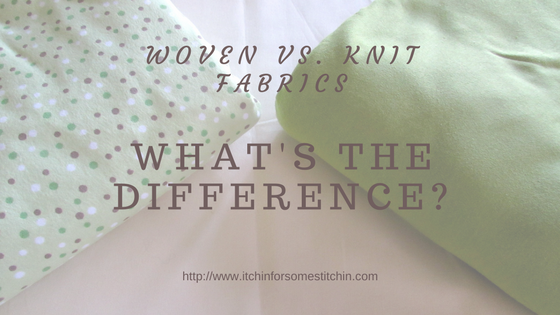
That’s because if you can’t tell a knit fabric from woven fabric you may end up purchasing the wrong type of fabric for your project. And that my friends, can be a sewing disaster.
Before You Start Sewing
I consider knowing the fabric differences a basic sewing skill. It’s something you really need to understand before you begin sewing. But, I believe there is a natural flow of learning that will make the sewing process easier.
First, make sure you are using the sewing machine that is right for you. After finding the perfect sewing machine, you then need to learn how to use it. You should also have a basic understanding of sewing machine stitches, especially the straight stitch and the zigzag stitch.
It’s also helpful to know the basic sewing tools and have them on hand before you start. My free e-book, Sewing Basics for Beginners: What You Need to Know Before You Start, is a helpful resource.
Once you have all that down, you should then do a little fabric research. Actually, there’s a good chance that fabric is one of the main things that draws you to sewing in the first place. Well, at least that’s the case for me.
Beautiful fabrics are eye-catching! It is so tempting to grab every lovely piece you see, even if you don’t have a plan or idea of what you are going to do with it. This is particularly bad if you are new to sewing because you may not realize that it is much harder to find a pattern that will work with fabric you’ve already bought than it is to simply buy the fabric required for a specific pattern.
It can be even more difficult if you’ve purchased the fabric with little or no knowledge about fabric in general. And as mentioned before, lack of fabric knowledge could mean purchasing the wrong fabric for your project.
Thus, I hope you are at least beginning to see that understanding the difference between fabric types is an important part of becoming an experienced sewer.
Types of Fabric
Basically, there are two types of fabrics. I know what you’re thinking. You’re thinking that’s a load of garbage because if you walk into a fabric store there are literally hundreds, if not thousands, of fabrics. And this is definitely true, but, all fabrics essentially fall into two categories: woven or knit.
All other fabric types are actually sub-categories of these two fabrics. The flow-chart below shows an example of how fabric types fall into categories and sub-categories.
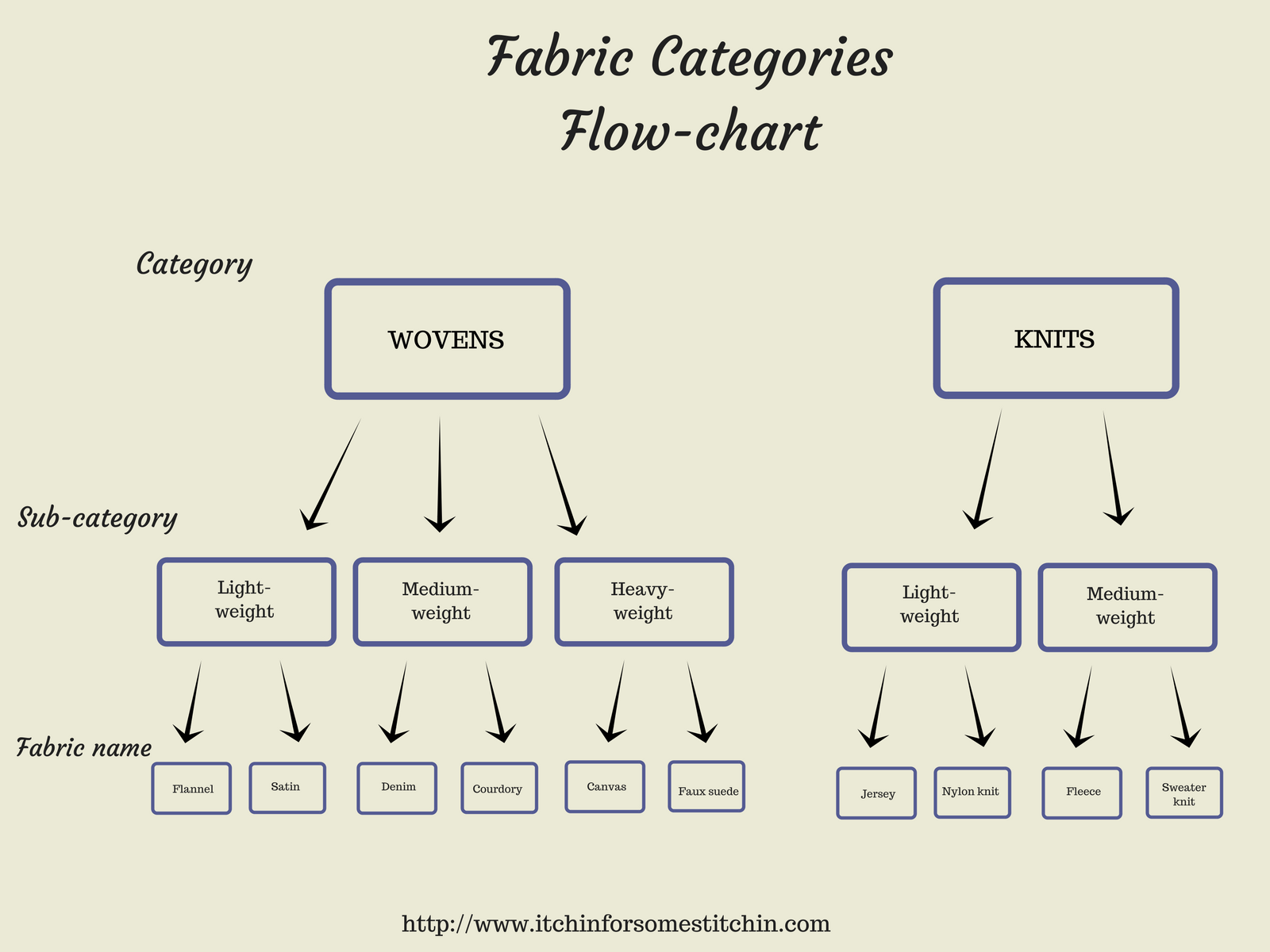
Difference Between Woven & Knit Fabrics
So what’s the difference between woven and knit fabrics? Well, the differences actually start with creation process of each fabric type. All types of fabrics are made through either a weaving or knitting process.
- Knitting machines create knit fabrics, but huge looms make woven fabrics.
Other differences have to do with fabric stretchability and washability.
- Woven fabrics will not stretch, but knit fabrics do.
- Knit fabrics shrink when washed while woven fabrics hold their shape.
Generally, woven and knit fabrics look quite different, yet many people find it difficult to differentiate between the two. When buying fabric, there are a couple of key things to look for if you are struggling to decide if the fabric in question is knit or woven.
- Check the lengthwise edge for round blobs of glue or starch. Knit fabrics tend to curl at the edges, these blobs keep the fabric straight. Woven fabrics will not have these blobs.
2. Inspect the cut edge (also called width) for fraying. Knit fabric edges do not fray. On the other hand, the ends of woven fabrics do fray and will need special care to keep the fibers from coming apart. See How to Keep Fabric Ends from Fraying for review.
After you’ve determined if your fabric is knit or woven, you should keep a couple other differences in mind when making your projects, especially if you are making an article of clothing. Knit fabrics are more comfortable, warm, and wrinkle-resistant. On the other hand, woven fabrics are more durable and more fade resistant than knit fabrics.
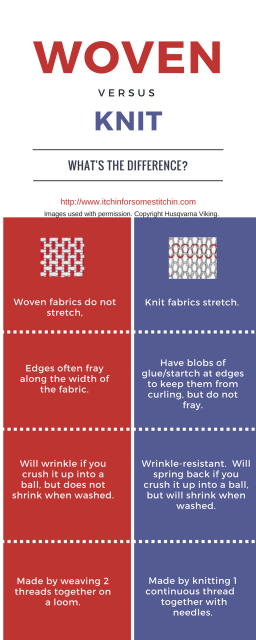
Now that you know the difference between woven and knit fabrics, let’s discuss each of these categories in a bit more detail.
Woven Fabrics
When you think of woven fabrics, think about your favorite button-down shirt, trousers, tote bag, or quilt. These fabrics are made by weaving two threads together just like a basket but on a smaller scale. They can be made from natural or synthetic fibers and range from delicate weaves (think silk) to large weaves (think burlap).
A loom converts these threads into fabric by intersecting them at right angles. This forms grain lines. The threads that run lengthwise are called warp and the threads that run across the width are called weft. Most woven fabrics have a right side and a wrong side, you’ll notice this as soon as you see the fabric.
Woven fabrics are sturdy and reliable, but eventually, the threads that hold them together will gradually pull away at the edges causing them to unravel. This is called fraying. This usually occurs along the cut edge, which is the width (weft threads). The lengthwise edges (called selvages), however, are strong and do not move.
One distinguishing feature of woven fabrics is their lack of stretch. However, today, some woven fabrics, such as denim, are made stretchable by adding spandex (which is the generic name for Lycra) in between.
Woven fabrics are often weaved in an array of colors and patterns. The dyes used do not to run or bleed once dry, making them colorfast or permanent. Thus, they usually don’t fade quickly.
One disadvantage is that woven fabrics tend to wrinkle greatly. Be sure to invest in an iron and ironing board if you choose to sew with a lot of these fabrics!
- Image used with permission. Copyright Husqvarna Viking.
- Woven fabric
Knit Fabrics
Knit fabrics are, in fact, literally knit–just like you would knit something with needles and a ball of yarn. However, it’s done on a smaller scale with tiny needles and very thin yarn (thread). The needles make interlocking loops out of one continuous piece of thread creating what looks like tiny rows of braids.
These interlocking loops make the fabric stretchable, which makes them ideal for making clothing and wearable accessories because they conform to the body. And since knit fabrics are actually a single thread the raw edges don’t unravel like woven fabrics.
Knit fabrics are generally fluffy, absorbent, and lightweight. Thus, they are comfortable to wear and are often the fabric of choice for many people. However, they don’t hold color as well as woven fabrics, which causes them to fade easily. They also shrink more than woven fabrics so they cannot be washed as often.
On the plus side, knit fabrics are wrinkle resistant. It crushes easily if you ball it up in your hand, but will spring back to its original shape once you release. No ironing needed! Your favorite T-shirt is a great example of a knit fabric.
- Image used with permission. Copyright Husqvarna Viking.
- Knit fabric.
Tips
Knowing fabric basics can make a trip to the fabric store less overwhelming. However, if you are hunting for a specific fabric type and find yourself lost among all the choices at the fabric store, here are a few tips to help you decide if the fabric is woven or knit.
The Stretchability Test
- Try stretching the fabric. It is a woven fabric if it doesn’t stretch. But if it does, then it’s a knit.
The Wrinkle Test
- Crush it into a ball in your hand and then release. If it springs back, it’s a knit fabric. However, if it wrinkles up, it’s woven.
The Blob/Fray Test
- Check the edges of the fabric before you have it cut. If there are blobs of glue or starch, it is a knit. The manufacturer put the blobs there to keep the ends from curling. Woven fabrics do not have these blobs, but will often fray along the width of the fabric.
If you found this post useful, please share it!
Until next time… Happy Sewing!

Resources:

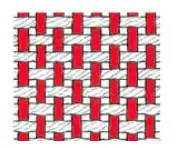

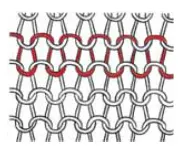
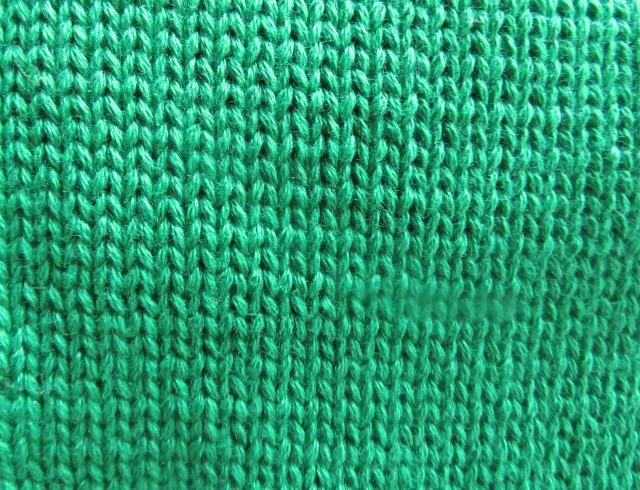
KItty
Thursday 25th of May 2017
I find that it's not so much the type of fabric that causes shrinkage, (knit or woven) but he fiber type. (natural or Artificial.) Polys don't shrink, Cottons do. All, or nearly all natural fibers shrink to a point. and wool shrinks always. which is why we used to be told not to wash it but brush it and air it and dry clean it once a year or as needed.
Anyways, the point of this was to mention that and to point out that while the knit fabrics don't necessarily shrink, they WILL stretch, due to gravity or around a large tummy etc. which can be a good thing or a bad thing depending on the look you desire.
Itchin4Stitchin
Thursday 25th of May 2017
Ah... you are so right! I had considered discussing fiber type in this article but decided it was too much. My intention with this post was to give a basic overview of the differences between wovens and knits and then dive into more detail in later articles. The next post will be about the fabrics that fall into the categories of woven and knits and then the following one will be about fiber types that make up woven and knits.
Your information about fiber types will go into that third post. I LOVE your tip about wools! Would you mind if I add it to my fiber types post? I have never heard it before. I was always taught that you can wash wools in cold and on delicate cycle, but you cannot dry them. They should be laid flat to dry.
And you are absolutely correct, knits do stretch, which is what makes them a great choice for clothing, but over time, they will definitely stretch out of shape. As you said, that can totally okay if that's what you want.
Thanks so much for your wonderful comment! Best wishes, RaeLynn.